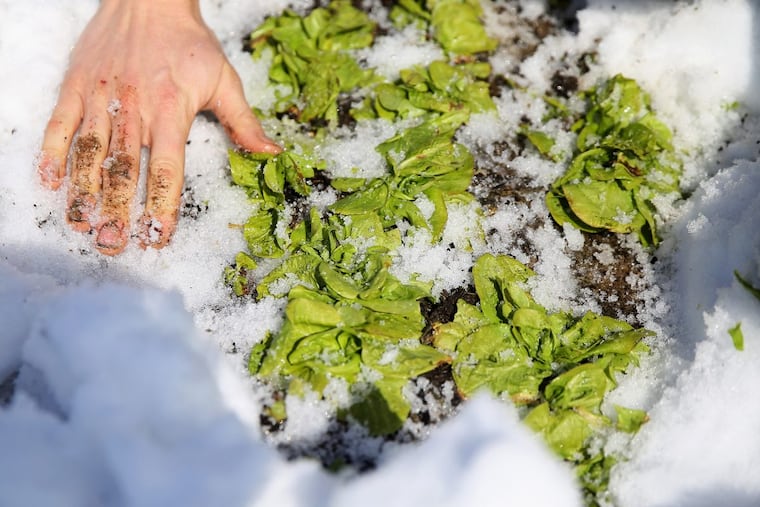For chefs, spring means greens are on the menu
A warmer winter has resulted in early crops of spring greens for some, meaning new dishes on farm-to-table restaurants.

Each spring, when the shoots peek up through the soil in the outdoor patio of Talula's Garden, owner Aimee Olexy's thoughts turn to lettuce. This year, some of the leafy greens to which she looks forward showed up a little early.
Produce like Bloomsdale spinach, a well-hydrated, sturdy leaf that holds up well to heat and is thick enough to cut with a knife. "You can sauce it and cook it and it doesn't turn to nothing," Olexy said. "And you just feel good when you eat it."
Setting aside recent snowstorms, the relatively mild winter resulted in a spring season that started early for some local farmers. That means menus at farm-to-table restaurants are already changing.
Warm weather followed by cold can hinder the season for some produce, like stone fruit, but once heartier plants come out early, they tend to stay out. Unlike cultivated crops, which often run for shorter seasons if they come in early, farmers say wild greens will typically enjoy longer seasons.
Andrew Wood, who owns Center City's Russet with his wife, Kristin, started getting watercress, stinging nettles, and other wild greens about two weeks early. Unlike other crops, which can be hurt by a late snowfall, he said those would survive the recent bout of bad weather.
"The wild greens, even if they have a hard time for a few weeks, they'll come back," he said. "Not to compare them to weeds, but they have a hearty vitality."
Olexy, also co-owner of the Stephen Starr restaurant the Love, said she's getting lettuce as well as snap peas from greenhouses. She typically associates ramps with mid-March but said farmers in West Virginia are already harvesting them. Nasturtium, a crunchy, edible flower, is popping up south of Pennsylvania ahead of schedule.
Each spring, Olexy said, she endeavors to make sure the stars of the season get their due. Her team is working on a lettuce sauce to go with scallops, for example.
"Everybody wants strawberries; everybody wants asparagus," she said. "Lettuce just needs a little love this time of year."
Olexy plans to serve the Bloomsdale spinach with Chesapeake rockfish, a striped bass that is also in plentiful supply this year, along with a fragrant broth with cilantro and other herbs.
"Herbs, to me, are a nice sensation of spring," she said. "I try to bring the softer herbs, move away from the harder winter ones, like rosemary and sage."
Wood said his menu is getting lighter with the addition of spring greens. He just started serving watercress with a mustard dressing and layering it over a golden beet custard with pickled mushrooms.
"Less butter," he said. "More salad."
The weather and temperature affect cheeses, too. The sooner the grass comes up, the sooner the spring goat cheese can be made.
And growth can vary even from county to county. Mike Griffiths, co-owner of farm-to-table restaurants Helm, South Helm, and Tierce, said last week that although he has started to see lettuce coming in, the farmers he works with have not yet brought in an early bounty. "In a few weeks, we should start seeing some rhubarb, some spring peas," he said.
At Heritage Farm in Philadelphia, manager Adrian Galbraith-Paul said spinach is coming in, as are some other leafy green crops that weathered the cold snap. Beneath layers of snow, crops like Italian chicory and radicchio are flourishing. Soon, he expects to start harvesting arugula and baby greens.
In recent years, the winter's first frost has been hard to predict, said Galbraith-Paul, whose farm sells produce to about 15 local restaurants, including Talula's, Fork, and Vetri Cucina. The first frost of 2017 came late, in December, and brought a lower-than-normal temperature, in the low 20s instead of the low 30s.
"As a grower, you're constantly making these bets about when to put things in the ground," he said. "Sometimes you just hope for a few sunny days before the snow."